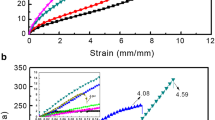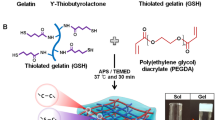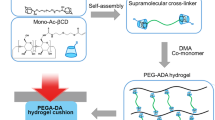Abstract
Strain-stiffening is a mechanical response that mimics the behavior of biological tissues. In this study, we fabricated and characterized P(TM co SA-CAA) hydrogel. These hydrogels were referred to as SA, 0.75 SA + 0.25 CAA, 0.5 SA + 0.5 CAA, 0.25 SA + 0.75 CAA, and CAA. Scanning electron microscopy of the hydrogel revealed that the nanofibrillar networks were homogeneously and compactly connected. Notably, the addition of SA-CAA led to remarkable improvement (of 260 kPa and over fourfold) in the elastic modulus and elongation at the break point. The best strain-stiffening was observed for the 0.5 SA + 0.5 CAA hydrogel. Additionally, the investigation of P(TM co SA-CAA) hydrogel mechanism viability and proliferation revealed no toxicity. The strain-stiffening property of P(TM co SA-CAA) facilitates the adhesion of cells. These results suggest that the strain-stiffening of self-assembled P(TM co SA-CAA) hydrogels may be appealing for biomedical applications.
Similar content being viewed by others
References
N. Zolfaghari, M. Moghimi Zand and M. R. K. Mofrad, Strain-stiffening and strain-softening responses in random viscoelastic fibrous networks: interplay between fiber orientation and viscoelastic softening, Soft Materials, 18 (2020) 373–385.
F. Meng and E. M. Terentjev, Nonlinear elasticity of semi-flexible filament networks, Soft Matter, 12 (2016) 6749–6756.
B. Fereidoonnezhad, C. O’Conno and J. P. McGarry, A new anisotropic soft tissue model for elimination of unphysical auxetic behaviour, Journal of Biomechanics, 111 (2020) 110006.
J. John, D. Ray, V. K. Aswal, A. P. Deshpande and S. Varughese, Dissipation and strain-stiffening behavior of pectin-Ca gels under LAOS, Soft Matter, 15 (2019) 6852–6866.
M. Fernandez-Castano Romera, R. P. M. Lafleur, C. Guibert, I. K. Voets, C. Storm and R. P. Sijbesma, Strain stiffening hydrogels through self-assembly and covalent fixation of semi-flexible fibers, Angew. Chm. Int. Ed. Engl., 56(30) (2017) 8771–8775.
Y. Wang, Z. Xu, M. Lovrak, V. A. A. Le Sage, K. Zhang, X. Guo, R. Eelkema, E. Mendes and J. H. V. Esch, Biomimetic strain-stiffening self-assembled hydrogels, Angew. Chm. Int. Ed. Engl., 59(12) (2020) 4830–4834.
C. Shao, L. Meng, M. Wang, C. Cui, B. Wang, C.-R. Han, F. Xu and J. Yang, Mimicking dynamic adhesiveness and strain-stiffening behavior of biological tissues in tough and self-healable cellulose nanocomposite hydrogels, ACS Applied Materials Interfaces, 11 (2019) 5885–5895.
B. Yan, J. Huang, L. Han, L. Gong, L. Li, J. N. Israelachvili and H. Zeng, Duplicating dynamic strain-stiffening behavior and nanomechanics of biological tissues in a synthetic self-healing flexible network hydrogel, ACS Nano, 11 (2017) 11074–11081.
M. Vatankhah-Varnosfaderani, A. N. Keith, Y. Cong, H. Liang, M. Rosenthal, M. Sztucki, C. Clair, S. Magonov, D. A. Ivanov, A. V. Dobrynin and S. S. Sheiko, Chameleon-like elastomers with molecularly encoded strain-adaptive stiffening and coloration, Science, 359 (2018) 1509–1513.
S. M. Hashemnejad and S. Kundu, Strain stiffening and negative normal stress in alginate hydrogels, Journal of Polymer Science, Part B: Polymer Physics, 54 (2016) 1767–1775.
L. Jin and Z. Suo, Smoothening creases on surfaces of strain-stiffening materials, Journal of the Mechanics Physics of Solids, 74 (2015) 68–79.
Z. Liu, Y. Faraj, X. J. Ju, W. Wang, R. Xie and L.-Y. Chu, Nanocomposite smart hydrogels with improved responsiveness and mechanical properties: a mini review, Journal of Polymer Science Part B: Polymer Physics, 56 (2018) 1306–1313.
S. Kudaibergenov, J. Koetz and N. Nuraje, Nanostructured hydrophobic polyampholytes: self-assembly, stimuli-sensitivity, and application, Advanced Composites Hybrid Materials, 1 (2018) 649–684.
A. Vedadghavami, F. Minooei, M. H. Mohammadi, S. Khetani, A. R. Kolahchi, S. Mashayekhan and A. S. Nezhadd, Manufacturing of hydrogel biomaterials with controlled mechanical properties for tissue engineering applications, Acta Biomaterialia, 62 (2017) 42–63.
K. Bertula, L. Martikainen, P. Munne, S. Hietala, J. Klefström, O. Ikkala and Nonappa, Strain-stiffening of agarose gels, ACS Macro Letters, 8(6) (2019) 670–675.
F. Burla, J. Tauber, S. Dussi, J. van der Gucht and G. H. Koenderink, Stress management in composite biopolymer networks, Nature Physics, 15 (2019) 549–553.
M. Jaspers, M. Dennison, M. F. J. Mabesoone, F. C. MacKintosh, A. E. Rowan and P. H. J. Kouwer, Ultra-responsive soft matter from strain-stiffening hydrogels, Nature Communications, 5 (2014) 1–8.
Y. H. Tran, M. J. Rasmuson, T. Emrick, J. Klie and S. R. Peyton, Strain-stiffening gels based on latent crosslinking, Soft Matter, 13 (2017) 9007–9014.
X. Yang, H. Yano and K. Abe, Strain-stiffening composite hydrogels through UV grafting of cellulose nanofibers, Cellulose, 28 (2021) 1489–1497.
P. H. J. Kouwer, M. Koepf, V. A. A. Le Sage, M. Jaspers, A. M. van Buul, Z. H. Eksteen-Akeroyd, T. Woltinge, E. Schwartz, H. J. Kitto, R. Hoogenboom, S. J. Picken, R. J. M. Nolte, E. Mendes and A. E. Rowan, Responsive biomimetic networks from polyisocyanopeptide hydrogels, Nature, 493 (2013) 651–655.
E. Prince and E. Kumacheva, Design and applications of man-made biomimetic fibrillar hydrogels, Nature Reviews Materials, 4 (2019) 99–115.
H. Garcia-Seisdedos, C. Empereur-Mot, N. Elad and E. D. Levy, Proteins evolve on the edge of supramolecular self-assembly, Nature, 548 (2017) 244–247.
N. Singh, M. Kumar, J. F. Miravet, R. V. Ulijn and B. Escuder, Peptide-based molecular hydrogels as supramolecular protein mimics, Chemistry-A European Journal, 23 (2017) 981–993.
Y. Ji, X. Yang, Z. Ji, L. Zhu, N. Ma, D. Chen, X. Jia, J. Tang and Y. Cao, DFT-calculated IR spectrum amide I, II, and III band contributions of N-methylacetamide fine components, ACS Omega, 5 (2020) 8572–8578.
H. Ghimire, M. Venkataramani, Z. Bian, Y. Liu and A. G. Unil Perera, ATR-FTIR spectral discrimination between normal and tumorous mouse models of lymphoma and melanoma from serum samples, Scientific Reports, 7 (2017) 1–9.
S. Cao, M. N. Barcellona, F. Pfeiffer and M. T. Bernards, Tunable multifunctional tissue engineering scaffolds composed of three-component polyampholyte polymer, Journal of Applied Polymer Science, 133(40) (2016) 43985.
S. L. Haag and M. T. Bernards, Enhanced biocompatibility of polyampholyte hydrogels, Langmuir, 36 (2020) 3292–3299.
A. A. Abalymov, C. A. B. Santos, L. V. der Meeren, D. V. de Walle, K. Dewettinck, B. V. Parakhonskiy and A. G. Skirtach, Nanofibrillar hydrogels by temperature driven self-assembly: new structures for cell growth and their biological and medical implications, Advanced Materials Interfaces, 8 (2021) 2002202.
K. Abe and H. Yano, Formation of hydrogels from cellulose nanofibers, Carbohydrate Polymers, 85 (2011) 733–737.
A. Levin, T. A. Hakala, L. Schnaider, G. J. L. Bernardes, E. Gazit and T. P. J. Knowles, Biomimetic peptide self-assembly for functional materials, Nature Reviews Chemistry, 4 (2020) 615–634.
M. Chau, S. E. Sriskandha, H. Thérien-Aubin and E. Kumacheva, Supramolecular nanofibrillar polymer hydrogels, Advances in Polymer Science, 268 (2015) 167–208.
H. Charaya, L. Xinda, J. Nathan and H. J. Chung, Specific ion effects in polyampholyte hydrogels dialyzed in aqueous electrolytic solutions, Langmuir, 35 (2018) 1526–1533.
M. E. Schroeder, K. M. Zurick, D. E. McGrath and M. T. Bernards, Multifunctional polyampholyte hydrogels with fouling resistance and protein conjugation capacity, Biomacromolecules, 14 (2013) 3112–3122.
S. Van Helvert and P. Friedl, Strain stiffening of fibrillar collagen during individual and collective cell migration identified by AFM nanoindentation, ACS Applied Materials, 8 (2016) 21946–21955.
D. V. Parshin, A. I. Lipovka, A. S. Yunoshev, K. S. Ovsyannikov, A. V. Dubovoy and A. P. Chupakhin, On the optimal choice of a hyperelastic model of ruptured and unruptured cerebral aneurys, Scientific Reports, 9 (2019) 1–11.
M. Kirilova-Doneva, D. Pashkouleva and S. Stoytchev, Age-related changes in mechanical properties of human abdominal fascia, Medical Biological Engineering Computing, 58(7) (2020) 1565–1573.
Y. J. Liu, L. H. Fu, S. Liu, L. Y. Meng, Y. Y. Li and M. G. Ma, Synthetic self-assembled homogeneous network hydrogels with high mechanical and recoverable properties for tissue replacement, Journal of Materials Chemistry B, 4 (2016) 4847–4854.
D. Rüdiger, K. Kick, A. Goychuk, A. M. Vollmar, E. Frey and S. Zahler, Cell based strain stiffening of a non-fibrous matrix as organizing principle for morphogenesis, Cell Reports, 32(6) (2020) 108015.
V. F. Fiore, S. S. Wong, C. Tran, C. Tan, W. Xu, T. Sulchek, E. S. White, J. S. Hagood and T. H. Barker, αvβ3 integrin drives fibroblast contraction and strain stiffening of soft provisional matrix during progressive fibrosis, JCI Insight, 3(20) (2018) e97597.
F. Eskandari, M. Shafieian, M. M. Aghdam and K. Laksari, Tension strain-softening and compression strain-stiffening behavior of brain white matter, Annals of Biomedical Engineering, 49 (2021) 276–286.
Acknowledgments
The research was supported by the Ministry of Science and Technology, Taiwan [MOST109-2221-E-110-023].
Author information
Authors and Affiliations
Corresponding author
Additional information
Gustini is currently a Ph.D. student at the National Sun Yat-sen University, Taiwan. Her research interests include development and application in bioengineering and biomedical.
Wei-Chih Lin is currently an Associate Professor with the National Sun Yat-sen University, Taiwan. His Ph.D. is from Cambridge University, UK. His research interests include development and application in bio-engineering, biomedical and agriculture machinery.
Rights and permissions
About this article
Cite this article
Gustini, Lin, WC. Characterizations of the strain-stiffening property and cytotoxicity in the self-assembled polyampholyte hydrogel. J Mech Sci Technol 36, 2653–2661 (2022). https://doi.org/10.1007/s12206-022-0446-6
Received:
Revised:
Accepted:
Published:
Issue Date:
DOI: https://doi.org/10.1007/s12206-022-0446-6




